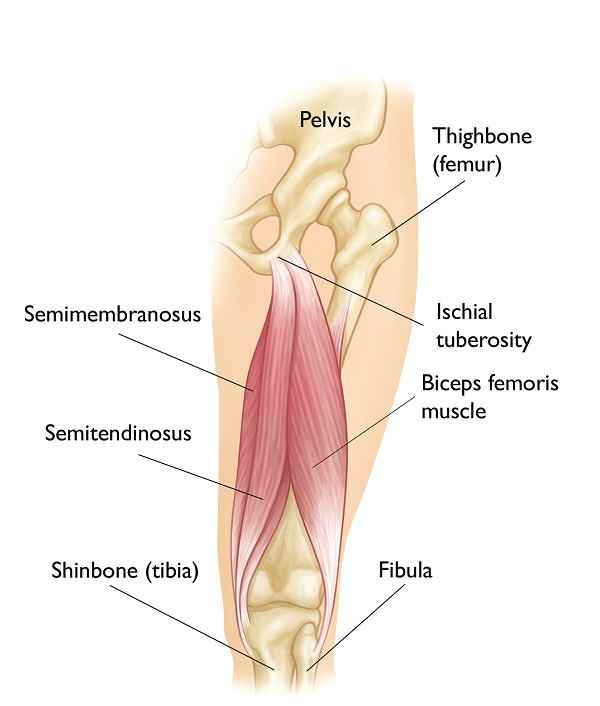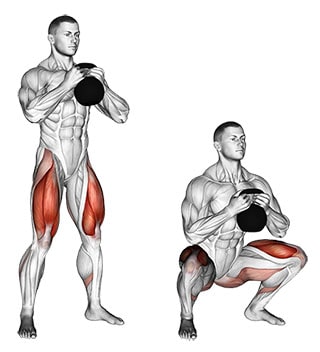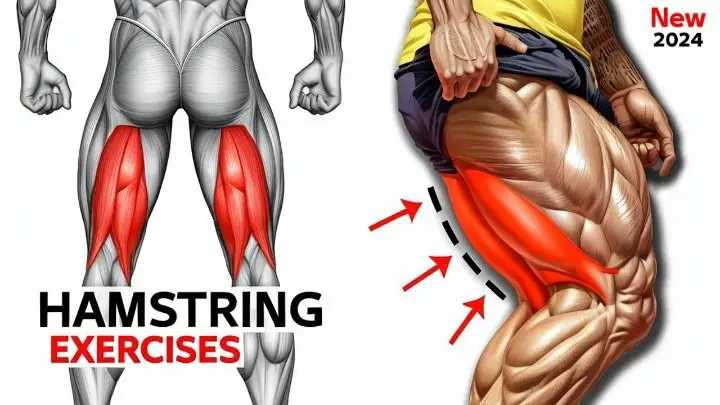Are you tired of the same old leg day routine and looking for a fresh, effective exercise to spice things up? Enter the goblet squat—a versatile and increasingly popular move in the fitness world. But here’s the burning question: does this powerhouse exercise really work your hamstrings, or is it just another quad-dominant move?
In this article, we’ll break down the mechanics of the goblet squat, look at the muscles it targets, and focus on how it affects the hamstrings. Whether you’re a seasoned lifter or new to working out, understanding how different exercises impact various muscle groups can help you fine-tune your workouts to reach your fitness goals.
Anatomy of the Hamstrings

The hamstrings are a group of three muscles located at the back of the thigh. They play a crucial role in many movements, including walking, running, and squatting. Here’s a detailed look at the anatomy of the hamstrings:
- Biceps Femoris: This muscle has two heads, the long head and the short head. It’s positioned on the outside part of the thigh and is responsible for flexing the knee, extending the thigh at the hip, and rotating the lower leg when the knee is bent.
- Semitendinosus: Located between the biceps femoris and the semimembranosus, this muscle helps in knee flexion, thigh extension at the hip, and medial rotation of the hip and lower leg.
- Semimembranosus: This muscle is situated closest to the middle of the body, underneath the semitendinosus. It also aids in bending the knee, extending the thigh, and medially rotating the hip and lower leg.
SHOP FOR THE ADJUSTABLE DUMBBELL SET ON AMAZON
The hamstrings originate from the ischial tuberosity in the pelvis and insert into the bones of the lower leg, the tibia, and fibula. They are innervated primarily by the sciatic nerve and have a rich blood supply from the inferior gluteal artery and the perforating branches of the deep femoral artery.
Understanding the anatomy of the hamstrings is essential for recognizing their function during exercises like the goblet squat and for designing effective training programs to strengthen these muscles.
What is a Goblet Squat?

The Goblet Squat is a compound exercise that is highly effective for building strength in the lower body. It targets the quadriceps, glutes, and hamstrings as primary muscles, with the abdominals, adductors, and spinal erectors serving as secondary muscles involved in the movement.
To perform a Goblet Squat:
- Stand with your feet roughly hip-width apart, toes facing forward.
- Hold a dumbbell or kettlebell with both hands at chest level, close to the body.
- Push your hips back and bend your knees to lower down into a squat, aiming to get your hips below parallel with your knees.
- Keep your back straight and chest up throughout the movement.
- Press through your heels to return to the starting position, engaging your glutes as you rise.
The equipment needed for this exercise is minimal, making it accessible to many people. You’ll need either a dumbbell or kettlebell to add resistance to the squat. The level of difficulty for the Goblet Squat ranges from beginner to advanced, depending on the weight used and the individual’s fitness level. It’s a versatile exercise that can be adapted to suit different strength levels and is also a great way to progress to more complex squat variations, such as the weighted front squat.
SHOP FOR THE KETTLEBELL ON AMAZON
Overall, the Goblet Squat is a great full-body exercise that not only builds muscle in the legs, core, and glutes but also develops cardiovascular fitness, making it a valuable addition to any workout routine.
Muscles Targeted by Goblet Squats
Goblet squats are a versatile exercise renowned for their ability to target multiple muscle groups simultaneously. Primarily, goblet squats engage the quadriceps, which are the muscles at the front of the thighs responsible for knee extension. This exercise also heavily recruits the gluteal muscles, particularly the gluteus maximus, which is the largest muscle in the buttocks and plays a crucial role in hip extension. Additionally, goblet squats require significant activation of the core muscles to maintain stability and proper form throughout the movement, enhancing overall abdominal and oblique strength.
While goblet squats primarily target the quadriceps, glutes, and core, they also involve secondary muscle groups such as the hamstrings, calves, and lower back. The hamstrings, located at the back of the thigh, act as synergists in the squatting motion, assisting the glutes in hip extension and contributing to knee flexion during the descent phase of the exercise. The calves, specifically the gastrocnemius and soleus muscles, stabilize the ankle joints and assist in maintaining balance throughout the squatting motion. Moreover, the lower back muscles, including the erector spinae, play a crucial role in spinal stabilization, especially during the squat’s descent and ascent phases.
Benefits of Running Without Shoes
Overall, goblet squats provide a comprehensive lower body workout that not only targets the major muscle groups like the quadriceps and glutes but also engages secondary muscles such as the hamstrings, calves, and lower back to promote overall strength, stability, and muscular development.
How Goblet Squat Works the Hamstrings?
The goblet squat, primarily known for targeting the quadriceps, glutes, and core, also engages the hamstrings, albeit to a lesser extent. When performing a goblet squat, the hamstrings play a crucial role in stabilizing the knee joint and aiding in hip extension. As you descend into the squat, the hamstrings lengthen and act eccentrically to control the movement, preventing you from dropping too quickly and maintaining balance. This eccentric contraction is vital for deceleration and contributes to overall hamstring engagement.
As you rise from the bottom of the squat, the hamstrings assist in extending the hips along with the glutes. Although the quadriceps take on most of the load during the concentric phase (the upward movement), the hamstrings provide essential support. This support is particularly noticeable when maintaining a neutral spine and proper hip hinge, both of which are key to performing a goblet squat correctly. By ensuring the pelvis remains in a stable position, the hamstrings help facilitate a smooth and controlled ascent, contributing to overall lower body strength and stability.
SHOP FOR THE RESISTANCE BAND ON AMAZON
However, it’s important to note that while goblet squats do engage the hamstrings, they are not the most effective exercise for isolating and developing hamstring strength. Exercises like Romanian deadlifts, leg curls, and hip thrusts are more targeted and efficient for hamstring hypertrophy and strength gains.
Benefits of Goblet Squat
The Goblet Squat is a versatile exercise with numerous benefits. Here are some key benefits of incorporating Goblet Squats into your workout routine:
Comparing Front and Back Squats
- Build Muscle: Goblet Squats can help stimulate your quadriceps, leading to muscle growth in your legs. They also engage your glutes and hamstrings, contributing to overall lower body strength.
- Get Stronger: Despite the typically lighter load compared to barbell back squats, Goblet Squats can still help you build strength.
- Functional Warm-Up: Goblet Squats can serve as a functional warm-up exercise, preparing your body for more intense workouts.
- Improve Hip Mobility: This exercise can enhance your hip mobility, which is beneficial for a variety of daily activities and other exercises.
- More Accessible to Beginners: Goblet Squats are often easier for beginners than other types of squats. The movement mimics many daily activities, making it a more natural and accessible exercise.
- Promotes Upright Posture: The position of the weight in Goblet Squats encourages an upright posture, which can improve your form and reduce the risk of injury.
- Alternative to Barbell Squats: If you’re experiencing lower back pain or discomfort with barbell squats, Goblet Squats can be a great alternative. They still target the quads and glutes but place less tension on your lower back.
- Increased Upper Back Strength: Holding the weight in front of your chest during a Goblet Squat can also help strengthen your upper back.
- Boost Core Strength: Since the weight is held in front of your body, your core has to work harder to support the movement, thereby strengthening your core muscles.
- Improve Mental Discipline: Goblet Squats require focus and discipline, especially when performed with heavier weights.
SHOP FOR THE SQUAT RACK ON AMAZON
Remember, it’s always important to perform exercises with proper form and technique to maximize benefits and minimize the risk of injury.
Common Mistakes in Goblet Squat
When performing goblet squats, it’s crucial to maintain proper form to ensure the exercise is effective and to avoid injury. Here are some common mistakes to watch out for:
- Holding the Weight Too Far From Your Body: The weight should be held close to your chest to maintain balance and control.
- Leaning Forward From the Waist: This can shift your center of gravity and place unnecessary stress on your lower back. Keep your torso upright.
- Rising Up On Your Toes: This mistake reduces hamstring and glute activation and can lead to instability. Keep your heels firmly planted on the ground.
- Knees Caving Inward: Also known as valgus collapse, this can put undue stress on the knee joints. Ensure your knees track in line with your toes.
- Not Utilizing the Full Squat Depth: Failing to achieve the full range of motion can limit the effectiveness of the exercise on the hamstrings and glutes.
- Incorrectly Holding the Dumbbell: The top end of the dumbbell should rest on your palms, not hanging by the fingers, to ensure proper support and stability.
- Letting the Arms Fall Forward: This can pull you off balance and make the squat more difficult, potentially leading to injury.
Muscle Growth with Functional Workouts
By avoiding these common errors, you can perform goblet squats more effectively and safely, maximizing the benefits of the exercise for your hamstrings and entire lower body.
Goblet Squat Variations
To enhance hamstring engagement during goblet squats, you can incorporate certain variations that shift the focus more toward the posterior chain. Here are some effective variations:
- Heels-Elevated Goblet Squat: Elevating your heels changes the angle of the squat, allowing for a deeper range and increased hamstring activation.
- Goblet Box Squat: By sitting back onto a box, this variation emphasizes the posterior chain, which includes the hamstrings and glutes. You can adjust the box height to work on squatting deeper.
- Sumo Goblet Squat: Adopting a wider stance with toes pointed out targets the inner thighs and glutes, but also involves the hamstrings due to the increased hip extension.
- Goblet Bulgarian Split Squat: This single-leg variation places more stress on the leg muscles, including the hamstrings, as they work harder to stabilize and control the movement.
- Goblet Squat With Lowering Resistance Band: Using a resistance band around the knees requires more effort from the hamstrings to maintain knee position during the squat.
- Goblet Squat 1 ¼: Adding a partial rep at the bottom of the squat increases time under tension for the hamstrings, as they have to work through a greater range of motion.
- Landmine Goblet Squat: The landmine setup provides stability, allowing you to focus on core engagement and maintain a neutral spine, which can indirectly benefit hamstring strength.
Comparing Hammer and Bicep Curls
Incorporating these variations into your workout can help you target the hamstrings more effectively during goblet squats.
FAQs
Q 1. Can goblet squats replace other forms of squats in my routine?
Ans. While goblet squats are a great exercise, they should be used in conjunction with other squat variations to target different muscle groups and add variety to your workout.
Q 2. Are goblet squats suitable for people with knee problems?
Ans. Goblet squats can be knee-friendly due to the upright torso position, but it’s important to consult with a healthcare professional before starting any new exercise.
Q 3. How often should I perform goblet squats?
Ans. The frequency of goblet squats in your routine depends on your overall fitness goals and the intensity of your workouts. It’s generally recommended to include them 2-3 times a week as part of a balanced training program.
Q 4. Can goblet squats improve my balance and coordination?
Ans. Yes, goblet squats engage your core and stabilizer muscles, which can help improve balance and coordination over time.
Q 5. How can I progress with goblet squats once they become easier?
Ans. You can increase the weight, add more reps or sets, slow down the tempo, or try more challenging variations to continue progressing.
Q 6. What are some common errors to avoid when increasing the intensity of goblet squats?
Ans. Avoid sacrificing form for heavier weights, ensure the full range of motion is maintained, and don’t rush the movements.
Conclusion
In conclusion, the goblet squat is a dynamic and adaptable exercise that serves as a cornerstone for lower body strength and conditioning. While it primarily targets the quadriceps and glutes, it also engages the hamstrings, albeit to a lesser extent. To maximize hamstring engagement, incorporating variations such as paused reps, elevated heel squats, or wider stances can be beneficial.
As with any exercise, proper form and technique are paramount to ensure safety and effectiveness. The goblet squat, with its simplicity and versatility, is a valuable addition to any fitness routine, offering a pathway to improved muscle strength, balance, and overall functional fitness. Whether you’re a beginner or an experienced athlete, understanding and utilizing the goblet squat can lead to significant gains in your fitness journey.

Good day, and welcome to Fitthour. My name is Shubham Vijay, and I am a certified personal trainer and nutrition coach with 6 years of experience in the fitness industry. At Fitthour, we specialize in types of training, such as strength training, cardio, or HIIT, and our mission is to help clients achieve their fitness goals and improve their overall health.



